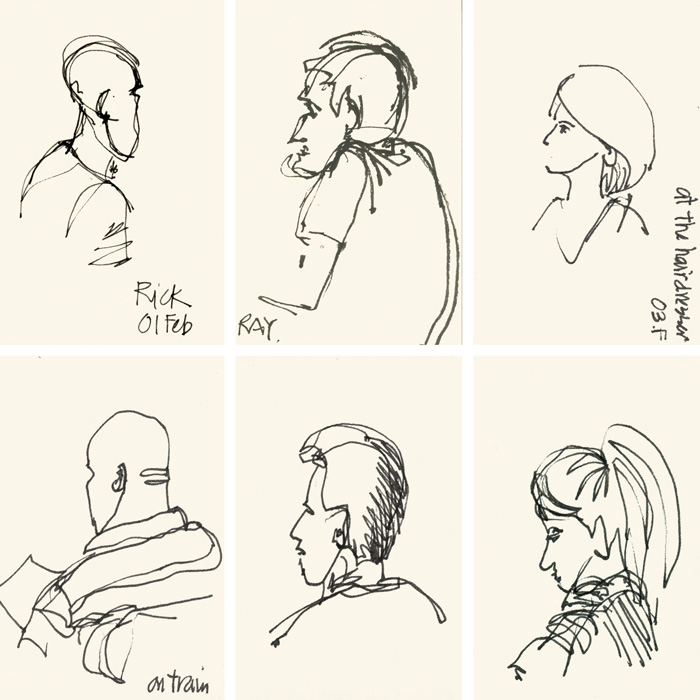
A few weeks ago I shared my big art goal for 2017 – to get people into my sketchbook – and four elements of my plan:
- Accountability
- Research
- Finding the best approach
- Doing it and correcting it.
And then, last week I gave you a quick update indicating that I have been sketching in a small book and some of the benefits of doing that. Today I want to give you a fuller explanation of what has been happening and my current strategy.
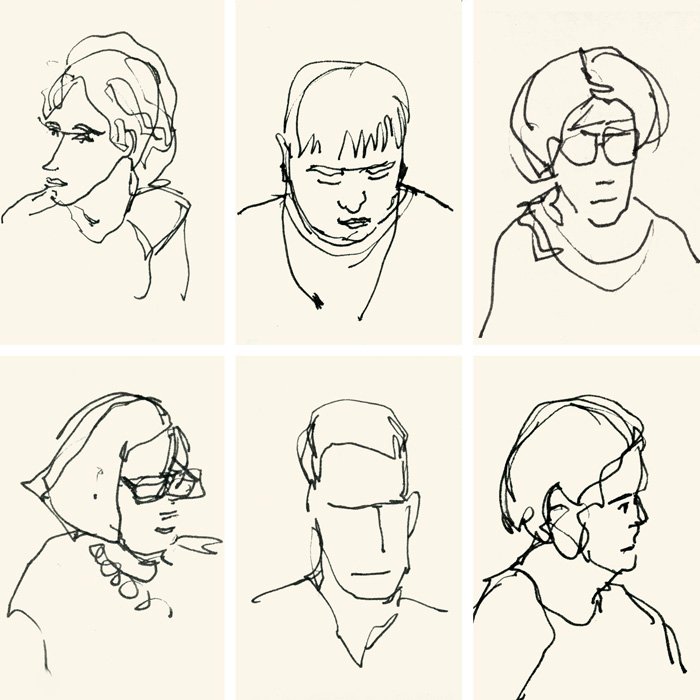
Firstly, my accountability partner is Chris Haldane and our plan is to meet every two-three weeks to review our process, share insights and struggles and set goals for the next meeting. We also send each other text messages during the week to report on our progress and wins. It is incredibly inspiring to be doing this with Chris – I was so pumped after our last meeting.
We are taking it slowly, looking at one aspect each per session with our big goal to feel comfortable with our people sketches (either individually or as part of a larger scene) in our normal sketchbooks by the end of April. Although I know I could easily start putting these people sketches in my daily book right now, I have deliberately decided not to at the moment as a way of focusing fully on the learning aspect.
We are both seasoned sketchers but are dissatisfied with our people sketches in relation to our other work, so our self-assessment of ‘being happy’ is at a high level. This level of expectation can be crippling if you are a beginner or have a tendency to be too hard on yourself, but for us, the goal of achieving a high standard is motivating us to work hard!
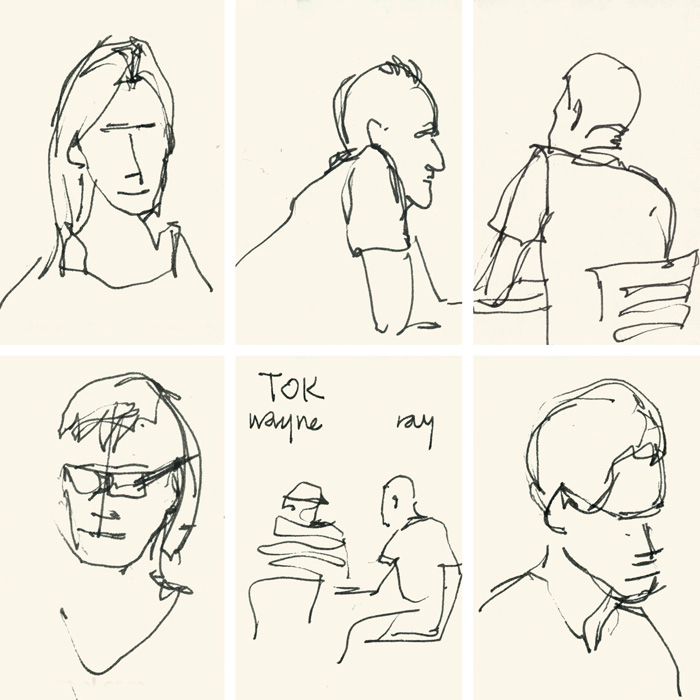
In the first fortnight of this project, I discovered that there are four aspects that I am working on, and which I believe essential to sketching (moving) people on location and also drawing directly in ink which presents a few more challenges than working in pencil. These are:
- Knowing enough anatomy to be able to draw a generic male and female in a number of standard poses. As people move so much you have to be able to complete a sketch using your memory.
- Being able to capture the gesture – the best gesture (decisive moment) to tell a story about the person and what they are doing. I will be re-visiting Suhita’s wonderful Craftsy course for this!
- Having a system for drawing the figure i.e. where to start, what order to draw the elements.
- Developing your own shorthand for features and elements of the figure.
These four aspects need to be developed at the same time, but at the moment I am focusing a little more on the first point.
There have been a lot of ideas floating around my head in the last few weeks, so here is a random list of the most important ones:
- I have been focusing initially on the volumes of the head. This is quite different from previous occasions where I was more interested in the face and features. I feel as if this has already made a huge difference for me. It is super helpful to be learning to see the whole skull rather than just the face as it relieves a number of ‘object brain’ problems such as drawing features too big.
- In order to train my reflex actions, one evening I spent time do multiple tracings of a skull profile, and then drawing it and checking my lines for accuracy. This seems to have been very effective in cementing the shapes and relationships into my hand movements
- My goal for this first period was to see and draw the shape and position of the skull. So I suspended judgment on other aspects (features, neck, torso, arms etc) – ‘I will get onto researching them later’, I told myself. I found this was really useful and by the end of the fortnight, my single line drawings were a lot more three dimensional than previously.
- Rather than drawing the axis lines down the centre of the face and through the eyeballs, I have been focusing more on eyebrows as they represent an edge on the skull. I also don’t want these axis lines in ink on my sketches.
- The big breakthrough for this first session was the importance of the ear at the intersection of three major components. The ear-eyebrow line (the tilt of the head), the ear-jawline (the shape of the face), and the ear-neck/spine axis (the overall posture.) I really haven’t thought about the ear much before, and although a major tip from Marc Taro Holmes’ Craftsy course was the ear-jaw connection, I felt everything clicked in place last week. I starting looking at people’s ears and was amazed at how that helped me see the volumes and gestures so much better.
I could go on and on, but I think that is enough for this week!
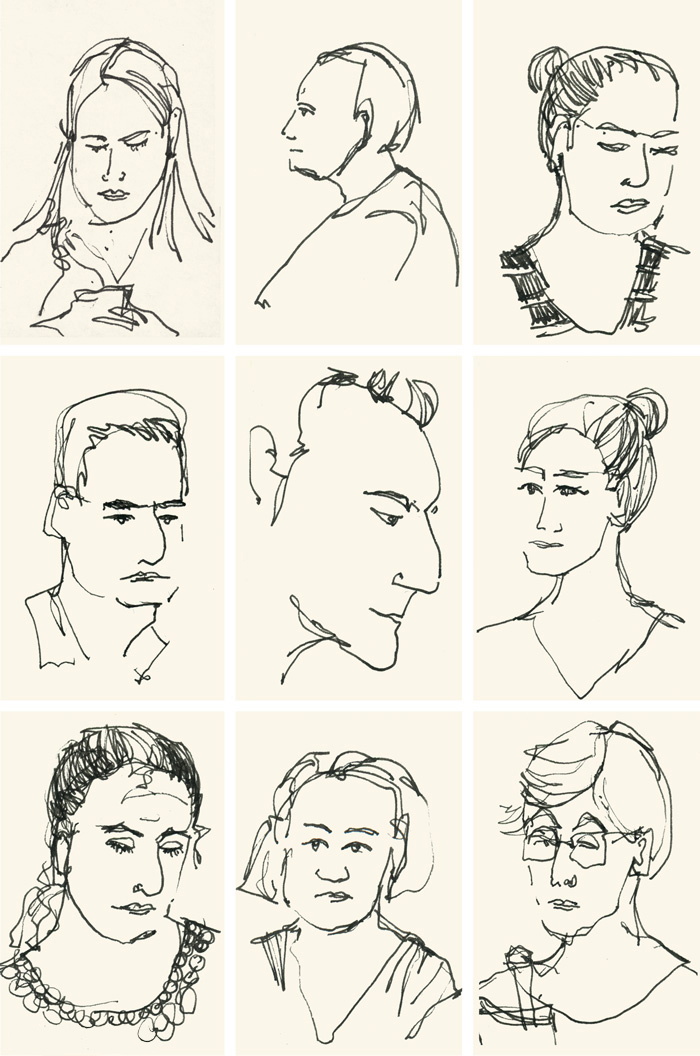
A little note about the sketches. These are a selection of sketches that I have done in my little book over the last 3 weeks. They are roughly in order and we all done super quickly – somewhere between 30 secs and 3 mins. Finally, I know that a few people asked for a list of recommended books. To be honest, I haven’t found one book (so far) that addresses all the things I need. Instead, I tend to look up a number of books and absorb a few different approaches, and then try to work it out for myself. Like the ‘ear’ lightbulb moment, it only became real because I was doing the work and ‘discovered it for myself’.
The moment when something clicks is what I am always searching for. It is easy for more seasoned sketchers to say: “Oh, yes, I have known that for years” but it is the personal moment of discovery that is the important thing – that only comes by doing!
As always, I am very interested in hearing your thoughts, challenges and/or tips – especially if you are someone that sketches a lot of people.

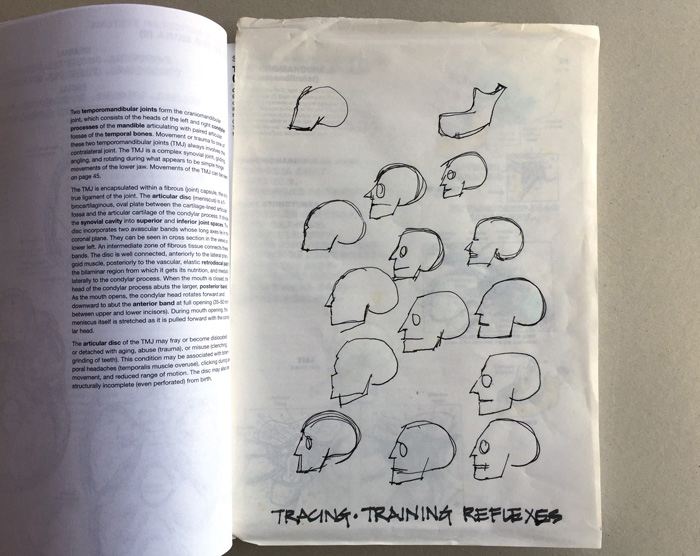




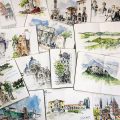
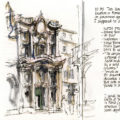
23 Comments
Really interesting Liz. I know that you have wanted to focus on people for a while . I do too – I want to focus on capturing the likeness of a personality . Everyone comes to it from their own background and experience. Perhaps that is what give each sketcher their own individual style. I drew people from magazines in my teenage years and know how the angle of a line can capture the personality of a person.
I have done a fair bit of life drawing and so that provided my with one approach to gestural drawing (put the structure in – draw the line shoulder to shoulder, hip to hip , spine). However when I draw on the tram or a crowd of people I have a completely different approach – from the top of the head down, profile – the hint of a nose and mouth
Each to their own . and practice practice practice
yes- great point about the difference from drawing posed figures to moving ones on trams etc. I loved watching you focus on drawing people when you were still in Sydney…and you really capture the gestures well! It needs that kind of dedication and focus for a time period to work out these strategies. Looking forward to sketching people with you soon.
A very interesting and informative post!- I think you are absolutely right that you have to have a generic set of figures in your head because people move so fast but I always struggle with acting on this because I want to be able to see a reality rather than a stylised sketch- how realistic this aim is remains to be seen! I have always tried to immerse myself in different sorts of people drawing to improve my proportion and gesture work including life drawing; drink and draw , keeping a little book etc and I guess then it’s practice practice practice. One of my favouritrle loosening up approaches and I also find it often improves my gesture is ‘colour first’ before the linework – somehow it loosens me up to be more insightful in my linework.
One of my favorite books for anatomy reference is Anatomy For The Artist by Sarah Simblet. It is a beautiful book with transparent overlays so you can fully understand anatomy. She also has a wonderful book Sketch Book For The Artist.
A lovely book with many racial groups represented. The limitation I see is the conventional choice of young beautiful people. These figures do give us the foundational elements but not the distortions and exaggeration that come from age, obesity, injury, and infirmity. I don’t know of a book that covers these aspects of anatomy so this isn’t meant as a criticism of this book specifically just a reminder that the subjects of our sketches often include people who aren’t the prototypical young beautiful white person.
What is the significance of the book underneath your page of skull tracings and drawings?
It’s not significant enough for me to list it. It was just a book with a nice sized profile of a skull for sketching. For the record it is a medical anatomy coloring book!!! Fun but certainly not essential
Took Marc Holmes course when it first came out but it seemed so far ahead of my abilities that I never noticed the ear/jaw emphasis. Have been sketching people more lately and am loving following your new interest in drawing people. Thanks for being a constant inspiration.
I am reading “Drawing on the Right Side of The Brain” and Edwards has a number of formulas for the ear, eye and neck locations that seem to be pretty universal. I am also curious about what book you used for tracing the skull to get started. I remember being very surprised years ago to find out the eyes are in the middle of the face, half-way down the skull.
Hi, Liz, really interesting to see your development in the sequence! The first ones were great quick drawings, but as you did it over time personality is emerging! Great challenge! Thanks for showing this to us, I look forward to seeing more as time goes by! Elsie
Love your strategy and commitment. I am finding short pose (2 – 10 min) life drawing sessions really helpful. I also have a separate small sketchbook and pencil to sketch people on trains, at the mall, in waiting rooms, wherever there is an opportunity. I have learnt that most people move between limited number of positions, so I usually sketch a few people at once, coming back to a person when they return to the position I am sketching.
My sketchbook doesn’t contain much people as it used to. I used to take public transport to the city daily, seeing lots of people. Now I live far off, not even much people passing by or in town in winter ( even the train station is empty and I was used to a cool and buse one-Antwerp central station). But this post inspires me to start looking for places where I can find people like the library in the small city rather close to us. It might also be a good way to connect with our new home/town/country.
Great post, Liz!
Really enjoyed your post. Thanks for all the tips. I’ve got a bit lazy drawing people but you’ve inspired me to have another go. Your sketches have really improved in a very short time. I can see your confidence has improved too as you are going for the front view rather than the safer option of the back of the head!
Great tips Liz! There is also Adebanji Alade – London sketcher worth to check: http://sketchinspiration.com/. He explains techniques and strategies of sketching people when they move and shows a whole ton of his sketches from London Tube.
I love this searching story of you. I do sketch people quit a lot, with different results. When asked I am unable to tell how I do what I do.
This article and information has been so helpful. Thank you for sharing your process, difficulties, challenges, solutions. You are so inspiring!
When we can’t explain how we do what we do in art it is good to admit that much of what we do is a God given talent and ability.
Sharon Matthews
Don’t make excuses for failure, just find a way for success
Hi I need help on drawing people
NEWSLETTER
Subscribe for first notification of workshop + online classes and more.